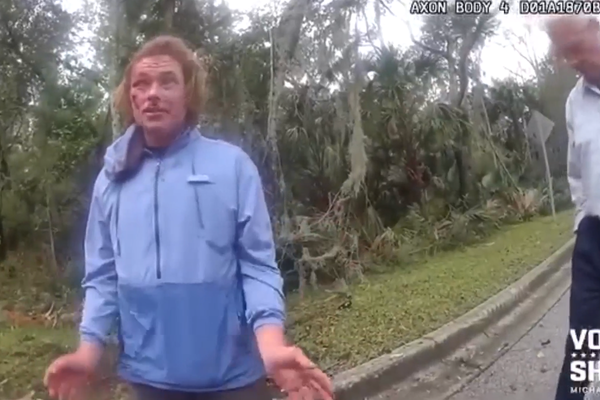
We walk in silvery light between freestanding screens and reflective mylar walls, and watch in a wintry garden outside Philadelphia. We sit in the gloom of Sir John Soane’s Museum, where someone jerks and twists in the doorway, and we float on the Yangtze as though in a Chinese painting. A dancer moulds a head on to his fist in wet clay, while standing in a vertical shaft of sunlight in Bahia, Brazil. Isaac Julien’s film installations take you places and catch you with their innumerable details and juxtapositions.
Light on black skin, shadows on white marble bodies, dry leaves rustling on a tiled floor, snow falling – and magically ascending – from the collar of a young man’s tuxedo. Lithe bodies slide between the sheets, and men in evening dress dance on tables. Here’s an angel, there’s little Jimmy Somerville up on a balcony. Julien can seduce and astonish, beguile and instruct. Walking through woodland, the formerly enslaved abolitionist Frederick Douglass encounters a body dangling from a tree. We only see feet and legs. No rope, no twisted neck. This image appears on just one of the array of 10 screens in Julien’s 2019 Lessons of the Hour, about Douglass’s sojourns and lecture tours in Britain and Ireland. This apparition of lynching is a disquieting memory resurfacing on a quiet walk in the Scottish countryside, a detail among details in this beautifully paced half-hour film.

Julien’s film installations can be ravishing, lyrical, languorous and sexy, and also at times horribly bleak. His work has come a long way. It has been consistently political, in the broadest sense, since the beginning. Still electrifying and urgent, Julien’s Territories (1984) was the artist’s calling card. It includes Super 8 footage, shot at Notting Hill carnival; news footage and overlays of riots and confrontations with the police; heady, urgent music and Julien’s haunting voiceover. After first seeing it while Julien was completing his undergraduate course in the film department at St Martin’s School of Art, it electrifies me still. Later, we jump from angry protests outside a north London police station to foundered fishing boats on the Italian island of Lampedusa; and from the dark and smoky clubs of the Harlem Renaissance, re-imagined in 1980s London, to the streets of Shanghai and a museum in São Paulo. It takes more than five hours to see all of Julien’s works in this survey of the artist’s 40-year career.
Territories, like other early works, is technically dated and very much of its period. His nearby 1987 This Is Not an Aids Advertisement, intended for TV and shown on a monitor, was intended as a corrective to the doomy TV ads about the dangers of unprotected sex that appeared nightly at the time. It is a paean to human pleasure as much as it was a requiem to loss. These early works cluster at the entrance to the show. Then we plunge right in.
With its freestanding screens multiplied by reflective walls, all illuminated by his sumptuous black-and-white film, Julien’s 2022 film installation Once Again … (Statues Never Die) takes as its subject the fraught relationship between businessman and art collector Arthur C Barnes and Alain Locke, philosopher and champion of the emerging Harlem Renaissance, and the first black Rhodes scholar at Oxford. The pair engage in a sort of Socratic dialogue, based on their respective writings, in a film that walks us between the endless glazed cabinets of the Pitt Rivers Museum in Oxford and climbs the seemingly endless Beaux Arts staircases at Philadelphia’s Barnes Foundation, where we also encounter jazz singer Alice Smith, whose soulful voice permeates the film. It’s intercut with archival footage of artists at work – a black post-impressionist working en plein air before the Brooklyn Bridge, portrait sculptor Richmond Barthé at work on a bust, scenes from mixed-race life classes, re-imagined by Julien. All this is riveting, but we soon move to more archival footage by Ghanaian film-maker Nii Kwate Owoo, shot in 1970, which has the film-maker delving into boxes in the basement of the British Museum in 1970, retrieving polythene-wrapped African masks and other artefacts. There is also footage from Chris Marker and Alain Resnais’ anti-colonialist 1953 film Statues Also Die, to which the title of Julien’s film nods. We re-encounter scenes from Julien’s 1989 film Looking for Langston. We also come across sculptures by Barthé and contemporary American artist Matthew Angelo Harrison, standing in odd corners of the installation, lit by the intermittent light spilling from the screens, in a disconcerting meeting of the real and the filmed. I could stay with this one work all day.

In the 2019 film Lina Bo Bardi – A Marvellous Entanglement we meet the Italian architect, who spent most of her career in Brazil. Her younger and older selves are played by leading Brazilian actors Fernanda Montenegro and Fernanda Torres, real life mother and daughter, whose words are all taken from Bo Bardi’s writings. She wrote that, “Linear time is a western invention; time is not linear, it is a marvellous entanglement, where at any moment points can be chosen and solutions invented without beginning or end.” This echoes Julien’s own approach. Looking for Langston transposes 1930s Harlem to London at the end of the 1980s. In the 2019 Lessons of the Hour, only some of Douglass’s audience, at a lecture he gave in Scotland in the 19th century, wear period costume. Talking about the primacy and democratisation of the photograph, Douglass addresses us as much as his earlier audience.
Misery is also at the heart of Julien’s 2007 Western Union: Small Boats and its 2010 companion piece, Ten Thousand Waves. None of the footage Julien shot in China for Ten Thousand Waves can compete with the raw emergency-service footage and the voices of police and coastguard responders recorded as the tragedy of the Morecambe Bay cockling disaster unfolded in 2004. Caught by the tide, more than 21 Chinese workers, many of whom spoke little English, drowned. The sprawl of complexities in Ten Thousand Waves, with its time-slips between past and present, between the hectic clamour of modern Shanghai and a vanished pre-revolution China, recreated here as a giant film set, as well as the scenes on the flooding mudbanks and tidal gullies of the bay in north west England, somehow self-sabotages the project.
You could say too many ideas, too many subtexts and references, but the qualities and richness of Julien’s work, and its ambition to deal with the complications of the world, and of history, is hugely impressive. Already familiar with most of the work, I still reeled out with a head full of unforgettable images, haunted by voices and reflections. Sometimes flawed and over-reaching, Julien’s art never forgets pleasure, among all the complications. You can’t have one without the other.







